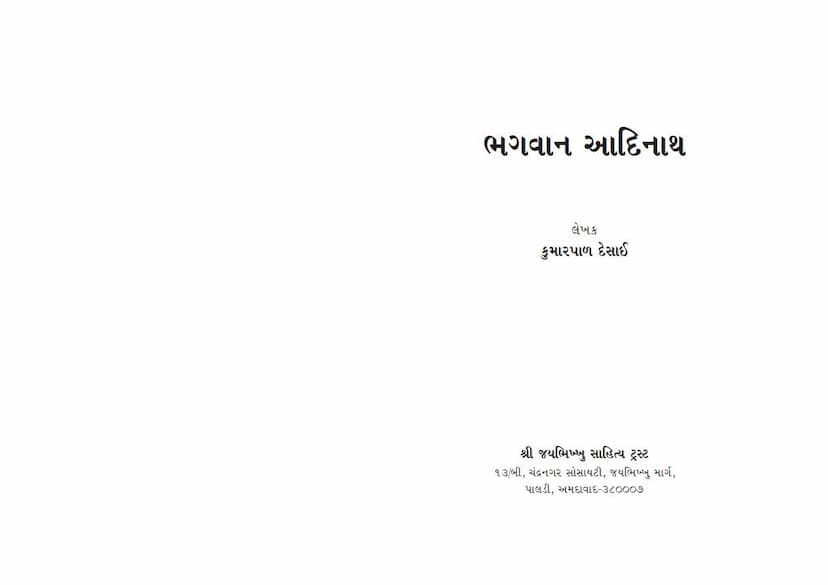Bhagwan Adinath
Added to library: September 1, 2025

Summary
Here is a comprehensive summary of the Jain text "Bhagwan Adinath" by Kumarpal Desai:
Book Title: Bhagwan Adinath Author: Kumarpal Desai Publisher: Jaibhikkhu Sahitya Trust
Summary:
The book "Bhagwan Adinath" by Kumarpal Desai narrates the life and teachings of the first Tirthankar of Jainism, Bhagwan Rishabhdev, also known as Bhagwan Adinath. The narrative begins by painting a picture of a primitive and idyllic past where humans lived in forests, consuming fruits, and experiencing a unique social structure.
The Early Times and the Decline of the Kalpavriksha: In this ancient era, men and women were born as couples called 'Yugaliya', living and dying together without experiencing separation. Life was simple, and people were easily guided by gentle admonishments. However, this utopian existence began to change as the abundance provided by the mythical Kalpavriksha trees diminished. This scarcity led to dissatisfaction, disputes over ownership, and the eventual emergence of conflict, selfishness, and the three modes of social interaction: 'Hakar Niti' (policy of acceptance/yes), 'Makar Niti' (policy of refusal/no), and 'Dhikkar Niti' (policy of condemnation).
The Birth and Early Life of Rishabhdev: During this evolving period, Queen Marudeva, wife of King Nabhi, gave birth to a radiant child. Due to the fourteen auspicious dreams she had during her pregnancy, particularly the dream of a white bull (Rishabh), the child was named Rishabhdev. He was born along with a girl whose auspicious appearance led to her being named Sumangala. Rishabhdev was later married to Sunanda, another beautiful maiden who was separated from her partner. This marked the first instance of marriage in their society. Rishabhdev had one hundred sons and two daughters. His prominent children were Bharat and Brahmi (from Sumangala) and Bahubali and Sundari (from Sunanda).
Rishabhdev as the First King and Civilizer: As societal structures deteriorated, Nabhikular (King Nabhi) established Rishabhdev as the first king. Lord Indra graced the occasion with Rishabhdev's coronation. In response to the people's struggles with digesting food and water, Rishabhdev introduced fundamental agricultural practices, teaching them to prepare and consume grains, build houses, make clothes from tree bark, and understand the use of fire. He also guided the development of various crafts and professions, including pottery, carpentry, weaving, painting, and sculpture. He educated his sons and daughters in various arts and sciences, laying the foundation for the spread of knowledge. He also established societal divisions and organized the kingdom, guiding humanity towards a structured way of life.
The Call for Renunciation and the Establishment of Dharma: Despite his significant contributions to the material well-being of his subjects, Rishabhdev realized that material comforts alone were insufficient. He understood the need for spiritual upliftment and the importance of renunciation. He recognized that without a spiritual path, humans would lose their humanity and become consumed by selfish desires. Therefore, he decided to establish the Dharma Tirth (the path of righteousness). The Lokantik Devas (celestial beings) appeared and requested him to lead humanity towards spiritual liberation.
The Great Renunciation and Austerities: After declaring his intention to renounce worldly life and embrace asceticism, Rishabhdev's decision caused great distress among his family and subjects. He meticulously divided his kingdom, appointing his eldest son Bharat as king, and initiated a year-long period of charitable giving ('Samvatsarik Dan'). On the eighth day of the waning moon in Chaitra, Rishabhdev renounced his royal attire and embraced the life of an ascetic, plucking out his hair with four fists, a momentous event witnessed by gods, demons, and humans. He attained 'Manahparyavagyan' (mind-reading knowledge) at this stage.
The First Fast and the Breaking of the Fast: The life of an ascetic is arduous, involving walking barefoot, enduring harsh weather, begging for alms, and sleeping on the ground. Rishabhdev underwent a rigorous fast for one year. During this time, despite the abundance of fruits and pure water, he did not accept any offerings, remaining absorbed in meditation. His vow was to accept only pure and blameless food. After a year, he arrived in Hastinapur, where Shreyans Kumar, the grandson of Bahubali, recognized him from past lives and was eager to offer alms. Shreyans Kumar humbly requested Rishabhdev to accept the juice of sugarcane, which was pure and free from any imperfections. Rishabhdev accepted the sugarcane juice, thus breaking his year-long fast. This event, on the third day of the waxing moon in Vaishakh, is celebrated as Akshaya Tritiya, signifying the importance of noble intentions and the value of selfless giving.
Attainment of Kevalgyan and the Teachings: After his initiation, Rishabhdev wandered across the land, meditating in various secluded places. A thousand years after his initiation, he attained Kevalgyan (omniscience). His teachings emphasized non-violence towards all living beings, truthfulness, non-stealing, chastity, and contentment. Many people embraced these principles, and Rishabhdev established the Sangha, which is also referred to as a Tirth. Hence, he is revered as the first Tirthankar. His spiritual assembly included a vast number of monks, nuns, scholars, enlightened beings, and lay followers.
Nirvana: As his time of liberation approached, Bhagwan Adinath proceeded to Mount Ashtapad. Renouncing all desires and establishing himself in equanimity, he attained Nirvana on the sixth day. The book concludes by stating that people still remember and venerate Bhagwan Adinath every morning.
In essence, the book provides a detailed account of the life of Bhagwan Adinath, from his divine birth to his role as the first king, civilizer, and ultimately, the revealer of the Jain path of salvation, highlighting his profound teachings and the significance of his life in shaping human civilization and spiritual understanding.